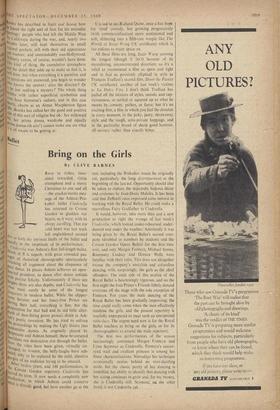Bring on the Girls
By OLIVE BARNES RAGS to riches, inno- cence rewarded, virtue triumphant and a merry Christmas to one and all —the cracker-motto mes- sage of the Ashton /Pro- kofiev ballet Cinderella has returned to Covent Garden to gladden our hearts, as it were, with its chirpy carolling. That my cold heart was last week left ungladdened seemed due to both the intrinsic faults of the ballet and 19nallY to the ineptitude of its performance.
", Li
k,(istch derella was Ashton's first full-length-ballet. of ft is superb, with great extended pas- sages of rhetorical choreography spectacularly er-Inching all argument about the eloquence of heart dance. In places Ashton achieves an open- .ed grandeur, as dance after dance unfolds ,:n.n Precise felicity. Unfortunately if there are Zillhts there are also depths, and Cinderella has hat must surely be some of the longest i:ng"elirs in modern ballet. While he slipper- Ose heroine and her fancy-free Prince are „aing their ball, everything is fine, but the PteParation for that ball and its sad little after- Math of shoe-fitting prove prosaic death to Ash- ,ein s Poetic invention. He has tried to enliven the Proceedings by making the Ugly Sisters into lilt°nlinle dames. As originally played by elPillann and Ashton himself, these be-corseted Nnarridans ran destructive riot through the ballet. OSY the roles have been given, virtually un- ,,nanged, to women, the belly-laughs 'have sub- 1(10, only to be replaced by the mild, abortive grilles of an audience trying to be amused. snAfter twelve years, and 140 performances, in c CoventGarden repertory Cinderella has ,ved its term. It now needs a completely new Pr,oduction, in which Ashton could conserve no is already good, but have another go at the rest, including the Prokoliev music he originally cut, particularly the long divertissement at the beginning of the last act. Opportunity should also be taken to replace the dejectedly hidcous d6cor and costumes by Jean-Denis Malc1S. it has been said that Zcffirelli once expressed some interest in working with the Royal Ballet. He could make a marvellous Fairy Godfather to Cinderella.
It would, however, take more than just a new production to right the wrongs of last week's Cinderella, which looked under-rehearsed, under- danced and under the weather. Admittedly it was being given by the Royal Ballet's second com- pany (doubled in numbers by students and the Covent Garden Opera Ballet) for the first time ever, and only Margot Fonteyn, Michael Somes, Rosemary Lindsay and Doreen Wells were familiar with their roles. This does not altogether excuse the company's unstylish and colourless dancing, with, surprisingly, the girls as the chief offenders. The male side of this section of the Royal Ballet is hearteningly vigorous, and on the first night the four Prince's Friends lithely danced everyone off the stage with the sole exception of Fonteyn. For years the male dancing of the Royal Ballet has been gradually improving; the time could easily come when the men effectively outshine the girls, and the present repertory is woefully unprepared to meet such an unexpected volte-face. The urgent need now is for the Royal Ballet teachers to bring on the girls, or for its choreographers to extend the male repertory.
The first two performances of the season fascinatingly contrasted Margot Fonteyn and Lynn Seymour as Cinderella. Fonteyn's saucer- eyed waif and exultant princess is among her finest characterisations. Nowadays her technique occasionally strains behind an over-dazzling smile, but the classic purity of her dancing is Undefiled, her ability to identify that dancing with her acting continues to grow and, for my money, she is Cinderella still. Seymour, ou the other hand, is not Cinderella yet.


























 Previous page
Previous page